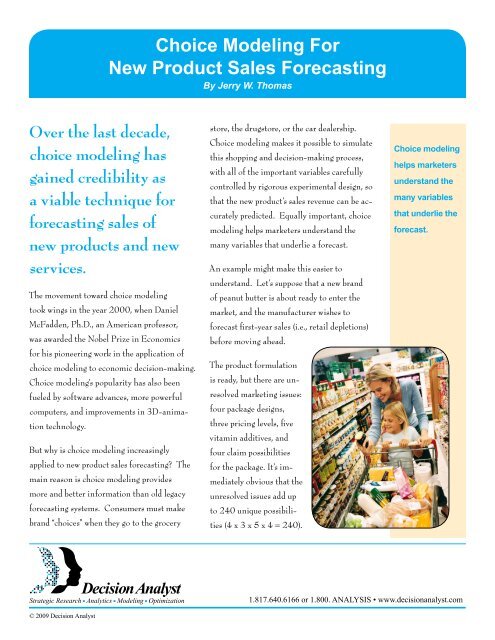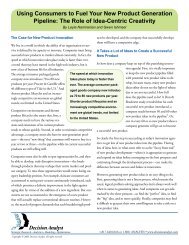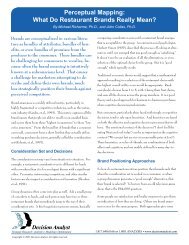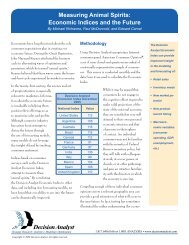Choice Modeling for New Product Sales Forecasting - Decision ...
Choice Modeling for New Product Sales Forecasting - Decision ...
Choice Modeling for New Product Sales Forecasting - Decision ...
You also want an ePaper? Increase the reach of your titles
YUMPU automatically turns print PDFs into web optimized ePapers that Google loves.
<strong>Choice</strong> <strong>Modeling</strong> For<br />
<strong>New</strong> <strong>Product</strong> <strong>Sales</strong> <strong>Forecasting</strong><br />
By Jerry W. Thomas<br />
Over the last decade,<br />
choice modeling has<br />
gained credibility as<br />
a viable technique <strong>for</strong><br />
<strong>for</strong>ecasting sales of<br />
new products and new<br />
services.<br />
The movement toward choice modeling<br />
took wings in the year 2000, when Daniel<br />
McFadden, Ph.D., an American professor,<br />
was awarded the Nobel Prize in Economics<br />
<strong>for</strong> his pioneering work in the application of<br />
choice modeling to economic decision-making.<br />
<strong>Choice</strong> modeling’s popularity has also been<br />
fueled by software advances, more powerful<br />
computers, and improvements in 3D-animation<br />
technology.<br />
But why is choice modeling increasingly<br />
applied to new product sales <strong>for</strong>ecasting The<br />
main reason is choice modeling provides<br />
more and better in<strong>for</strong>mation than old legacy<br />
<strong>for</strong>ecasting systems. Consumers must make<br />
brand “choices” when they go to the grocery<br />
store, the drugstore, or the car dealership.<br />
<strong>Choice</strong> modeling makes it possible to simulate<br />
this shopping and decision-making process,<br />
with all of the important variables carefully<br />
controlled by rigorous experimental design, so<br />
that the new product’s sales revenue can be accurately<br />
predicted. Equally important, choice<br />
modeling helps marketers understand the<br />
many variables that underlie a <strong>for</strong>ecast.<br />
An example might make this easier to<br />
understand. Let’s suppose that a new brand<br />
of peanut butter is about ready to enter the<br />
market, and the manufacturer wishes to<br />
<strong>for</strong>ecast first-year sales (i.e., retail depletions)<br />
be<strong>for</strong>e moving ahead.<br />
The product <strong>for</strong>mulation<br />
is ready, but there are unresolved<br />
marketing issues:<br />
four package designs,<br />
three pricing levels, five<br />
vitamin additives, and<br />
four claim possibilities<br />
<strong>for</strong> the package. It’s immediately<br />
obvious that the<br />
unresolved issues add up<br />
to 240 unique possibilities<br />
(4 x 3 x 5 x 4 = 240).<br />
<strong>Choice</strong> modeling<br />
helps marketers<br />
understand the<br />
many variables<br />
that underlie the<br />
<strong>for</strong>ecast.<br />
Strategic Research • Analytics • <strong>Modeling</strong> • Optimization<br />
1.817.640.6166 or 1.800. ANALYSIS • www.decisionanalyst.com<br />
© 2009 <strong>Decision</strong> Analyst
The whole<br />
shopping experience<br />
can be<br />
simulated online<br />
via 3D animation.<br />
This is where choice modeling comes to the<br />
rescue. By choosing a small subset of all these<br />
possibilities, following an experimental design,<br />
choice modeling permits the results <strong>for</strong> all<br />
240 possible combinations of variables to be<br />
accurately estimated.<br />
Here’s how it works . Once the experimental<br />
design is determined, each respondent sees and<br />
responds to a number of shopping scenarios.<br />
Think of a scenario as one shopping trip.<br />
The whole shopping experience<br />
can be simulated<br />
online via 3D animation,<br />
or just the “shelf set”<br />
itself can be simulated<br />
by 3D animation. Each<br />
participant sees a typical<br />
retail display, with all of<br />
the products in a category<br />
shown (the new product<br />
plus the major competitive<br />
brands). The respondent is<br />
asked to look at the shelf<br />
display and indicate how many of each brand<br />
she is likely to buy in the next week or next 30<br />
days. That completes one scenario.<br />
Then, the online “shelf set” systematically<br />
changes—prices change, claims change,<br />
package designs change, etc. The respondent<br />
is then asked to shop the peanut butter<br />
category again and choose exactly what she<br />
would buy in the next week or next 30 days,<br />
given the new shelf set. This completes the<br />
second scenario, and the process continues.<br />
Each respondent typically completes 6 to 10<br />
scenarios, and in each scenario the marketing<br />
variables are different.<br />
Since all of the marketing variables are carefully<br />
manipulated following an experimental<br />
design, the predicted market share (and sales<br />
<strong>for</strong>ecast) <strong>for</strong> the new peanut butter can be<br />
calculated <strong>for</strong> all 240 combinations. The<br />
equations that underlie the model are then<br />
used to build a <strong>for</strong>ecasting simulator, so that a<br />
research analyst or brand<br />
manager can play “what if”<br />
games by changing one or<br />
more marketing variables,<br />
to see the effects on<br />
market share (and yearone<br />
sales).<br />
Now, this elementary<br />
choice model is not quite<br />
ready <strong>for</strong> volumetric<br />
<strong>for</strong>ecasting yet. One<br />
of the most important<br />
variables is the quality or<br />
per<strong>for</strong>mance of the new product itself, and this<br />
variable must be incorporated into the choice<br />
model based on objective product testing data,<br />
since product quality largely determines the<br />
repeat purchase rate.<br />
Distribution build (i.e., percent of stores that<br />
will sell the new product month by month after<br />
introduction, weighted by store sales volume)<br />
is a major factor in the success of new products,<br />
so this variable must be added to the choice<br />
model.<br />
<br />
<strong>Decision</strong> Analyst
Another major variable is awareness build<br />
(how fast will awareness of the new brand<br />
grow during its first year, and what level will<br />
it attain by the end of year one), and this also<br />
must be added to the choice model.<br />
The final step is calibrating the choice model<br />
to actual category size, trends, and market<br />
shares. With these enhancements, the choice<br />
model is ready <strong>for</strong> sales <strong>for</strong>ecasting. A number<br />
of additional refinements to the model are<br />
possible, but these additional<br />
bells and whistles don’t add<br />
much predictive power.<br />
<strong>Choice</strong> modeling offers a<br />
number of advantages over<br />
the old legacy methods of<br />
new product sales <strong>for</strong>ecasting:<br />
<strong>Choice</strong> modeling is more<br />
“shopper” focused, or more<br />
focused on the “retail”<br />
shopping experience.<br />
This is relevant because<br />
new products today are<br />
more distribution- or retail-driven than<br />
new products in the past. That is, new<br />
brands today are seldom supported with<br />
media advertising to the degree they were<br />
30 or 40 years ago. Thus, what happens at<br />
point-of-purchase in the retail store is now<br />
all important. <strong>Choice</strong> modeling is superior<br />
to legacy methods in simulating this instore<br />
shopping experience.<br />
<strong>Choice</strong> modeling measures cause and<br />
effect precisely, so that analysts and brand<br />
managers know which marketing levers to<br />
pull to achieve specific business outcomes.<br />
<strong>Choice</strong> modeling permits hundreds of<br />
marketing scenarios to be explored in real<br />
time at no extra cost, compared to the<br />
inflexibility of the legacy systems (and the<br />
legacy costs <strong>for</strong> each scenario the client<br />
wants to evaluate). Most often, plans and<br />
budgets change as<br />
a new product is<br />
introduced, and the<br />
<strong>for</strong>ecasting simulator<br />
(and underlying<br />
choice model) makes<br />
it easy to analyze and<br />
optimize these onthe-fly<br />
changes.<br />
<strong>Choice</strong> modeling is<br />
calibration-based,<br />
not norm-based like<br />
the legacy systems.<br />
That is, the legacy <strong>for</strong>ecasting systems rely<br />
heavily on normative data from previous<br />
new product <strong>for</strong>ecasts, whereas choice<br />
models are calibrated to each product<br />
category based on current market size,<br />
brand shares, and trends. Norms tend to<br />
decay in relevance over time (older norms<br />
don’t tell us much about present-day<br />
realities), but calibration is always based on<br />
the most current and most relevant data—<br />
actual brand shares and sales volumes in<br />
the narrowly defined product category.<br />
<strong>Choice</strong> modeling<br />
is calibration<br />
based, not normbased.<br />
<strong>Choice</strong><br />
models are calibrated<br />
to each<br />
product category<br />
based on current<br />
market size,<br />
brand shares,<br />
and trends.<br />
<strong>Decision</strong> Analyst
<strong>Choice</strong> modeling can be applied to almost<br />
any product or service category with equal<br />
accuracy, since it is not based on normative<br />
data. None of the legacy systems<br />
have accurate norms <strong>for</strong> more than a few<br />
product categories. <strong>Choice</strong> models are<br />
based on calibration to the category, so lack<br />
of historical norms is not a limitation.<br />
<strong>Choice</strong> modeling lends itself to 3D animation,<br />
so that a virtual shopping experience<br />
with a realistic shelf set can be created.<br />
This added realism increases the accuracy<br />
of the sales <strong>for</strong>ecasts.<br />
Developing and introducing new products or<br />
new services is an inherently risky venture.<br />
No <strong>for</strong>ecasting system can guarantee success<br />
100% of the time. <strong>Choice</strong> modeling, however,<br />
can reduce the risks associated with the introduction<br />
of new products by providing more<br />
accurate <strong>for</strong>ecasts, especially <strong>for</strong> products<br />
without massive advertising support. <strong>Choice</strong><br />
modeling improves the marketer’s chances of<br />
success during the new product introduction,<br />
because the important marketing variables are<br />
incorporated into the <strong>for</strong>ecasting simulator.<br />
This allows the new products team to evaluate<br />
and respond quickly to changing circumstances<br />
as the new product rolls out. This simulator-based<br />
flexibility to respond correctly to<br />
changes in market conditions and competitive<br />
actions is often the difference between success<br />
and failure of many new products.<br />
<strong>Choice</strong><br />
modeling, can<br />
reduce the risks<br />
associated with<br />
the introduction<br />
of new products<br />
by providing<br />
more accurate<br />
<strong>for</strong>ecasts.<br />
About the Author<br />
Jerry W. Thomas is the President/CEO of <strong>Decision</strong> Analyst. The author may be reached by email at<br />
jthomas@decisionanalyst.com or by phone at 1-800-262-5974 or 1-817-640-6166.<br />
<strong>Decision</strong> Analyst is a leading international marketing research and analytical consulting firm. The company<br />
specializes in advertising testing, strategy research, new product ideation, new product research, and<br />
advanced modeling <strong>for</strong> marketing-decision optimization.<br />
Strategic Research • Analytics • <strong>Modeling</strong> • Optimization<br />
<br />
604 Avenue H East • Arlington, TX 76011-3100, USA<br />
1.817.640.6166 or 1.800. ANALYSIS • www.decisionanalyst.com<br />
Copyright © 2009 <strong>Decision</strong> Analyst. All rights reserved.





